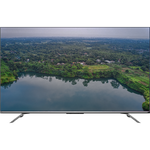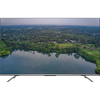A comparison of specs, key information, reviews, and best pricing from top retailers
Last updated -- hours ago | Report incorrect information
What we think

The PerfectRec TV team Learn more
Updated January 10, 2024·
If your priority is gaming, the Hisense U7G offers better performance with a higher gaming score and faster response time, but it is also more expensive. It also provides a better experience in both dark and bright rooms compared to the Hisense A65K, which is budget-friendly and performs adequately for watching news, talk shows, animations, and cartoons but has a poorer dark room performance and is not as well-suited for gaming. Both TVs offer similar sound quality and have an equivalent number of HDMI ports, but the U7G might be more future-proof with its higher refresh rate which could enhance viewing experience, especially for fast-moving content like sports and action movies. Give Feedback
this description is based on the product variant with some specs and product variant with some specs. At the time of writing, the variant with some specs cost some dollars and the variant with some specs cost some dollars.
Advantages of the Hisense A65K (LCD)
- The Hisense A65K (LCD) has no clear advantages over the Hisense U7G (LCD).
Advantages of the Hisense U7G (LCD)
- Good for bright room
- Good for dark room
- Very good for gaming
- Good for movies & TV
- Very good for news, talk, & other TV
- Good for use as monitor
Key differences
Picture Quality
6.7


7.6
5.64/10
CONTRAST
7.75/10
7.2/10
COLOR VOLUME SCORE
7.2/10
LED
PANEL TYPE
LED FALD
VA
PANEL SUB-TYPE
VA
The Hisense U7G (LCD) has good picture quality, while the Hisense A65K (LCD) has only fair picture quality.
Movies & TV
5.9


7.4
5.64/10
CONTRAST
7.75/10
6.3/10
BLACK UNIFORMITY
6.4/10
7.0/10
UPSCALING
7.5/10
Yes
HDR10 SUPPORT
Yes
No
HDR10+ SUPPORT
Yes
Yes
DOLBY VISION SUPPORT
Yes
The Hisense U7G (LCD) is good for movies & TV, while the Hisense A65K (LCD) is poor.
The Hisense U7G has significantly better contrast and black uniformity than the Hisense A65K, which matters a lot for movies where dark scenes are common; these features allow the U7G to display deeper blacks and more detail in shadows. Furthermore, the U7G's superior local dimming enhances its contrast, making it more suitable for cinematic content, while the A65K's weaker local dimming results in less impressive dark scene performance.
Gaming
5.9


8.0
6.8/10
RESPONSE TIME SCORE
7.0/10
8.7/10
INPUT LAG SCORE
7.6/10
3.5/10
MOTION PROCESSING
3.2/10
18.0/100
GAMING LOCAL DIMMING
70.0/100
6.0/10
GAME HDR BRIGHTNESS SCORE
8.2/10
The Hisense U7G (LCD) is very good for gaming, while the Hisense A65K (LCD) is poor.
The Hisense U7G excels in gaming mainly because it has a good response time, ensuring smoother motion, and good input lag, meaning less delay between your actions and what appears on screen, along with a higher refresh rate that contributes to a fluid gaming experience. On the other hand, the Hisense A65K has a fair response time and input lag which may result in more motion blur and noticeable delay during gameplay, and it offers a lower refresh rate, which is less optimal for fast-paced gaming.
News, Talk, & Other TV
6.7


8.1
7.2/10
SDR BRIGHTNESS SCORE
8.8/10
7.0/10
UPSCALING
7.5/10
The Hisense U7G (LCD) is very good for news, talk, & other TV, while the Hisense A65K (LCD) is only fair.
The Hisense U7G delivers better performance for news, talk shows, and TV programs due to its higher SDR brightness, which means it displays clearer images in bright rooms, and better upscaling capabilities that make lower-resolution content look more detailed. While the Hisense A65K also has decent upscaling and color accuracy, it falls behind in terms of brightness and contrast, making it less ideal than the U7G for such content, especially in well-lit environments.
Bright Room
6.4


7.7
5.3/10
VIEWING ANGLE
5.5/10
7.2/10
SDR BRIGHTNESS SCORE
8.8/10
6.2/10
HDR BRIGHTNESS SCORE
7.7/10
6.6/10
REFLECTIONS SCORE
6.3/10
The Hisense U7G (LCD) is good for bright room, while the Hisense A65K (LCD) is only fair.
The Hisense A65K has fair SDR brightness and reflections handling which may not be sufficient for very bright rooms, while the Hisense U7G has very good SDR brightness, better suited for such environments and good reflections handling, making it a more suitable choice for viewing in well-lit conditions. Additionally, the U7G's better HDR brightness enhances the viewing experience in bright conditions compared to the A65K, which has lower HDR brightness.
Cost
$370


$698
$200
$400
$600
$800
$1,000
$1,200
The Hisense A65K (LCD) has a price of $370 and the Hisense U7G (LCD) costs $698.

Let Us Help Find Your Perfect TV
Find your new TV
Key similarities
Sports
6.1


6.1
3.5/10
MOTION PROCESSING
3.2/10
60Hz
REFRESH RATE
120Hz
8.7/10
INPUT LAG SCORE
7.6/10
7.0/10
UPSCALING
7.5/10
7.2/10
SDR BRIGHTNESS SCORE
8.8/10
Yes
HLG SUPPORT
Yes
The Hisense U7G (LCD) and Hisense A65K (LCD) are both only fair for sports.
The Hisense A65K and Hisense U7G both offer fair performance for watching sports; the A65K has a slower response time and weaker motion processing, which may lead to more blur during fast action, but better viewing angles which could be preferable for larger groups. The U7G handles reflections better due to a higher reflections score, making it more suitable for well-lit rooms, and offers better uniformity making it less distracting during sports with uniform colors such as a football field.
Cartoons & Animation
7.3


7.7
7.6/10
COLOR GAMUT SCORE
7.7/10
7.2/10
COLOR VOLUME SCORE
7.2/10
7.2/10
SDR BRIGHTNESS SCORE
8.8/10
8.1/10
COLORS OUT OF THE BOX SCORE
6.4/10
5.7/10
GRAY UNIFORMITY
7.0/10
The Hisense U7G (LCD) and Hisense A65K (LCD) are both good for cartoons & animation.
The Hisense A65K is well suited for cartoons and animation as it displays very good colors straight out of the box, making it immediately vibrant and appealing for animated content, and also offers a good color gamut for a wide range of hues. On the other hand, the Hisense U7G, while also having a good color gamut, only offers fair performance for colors out of the box, which means it might require some adjustments for optimal color display but has better color volume, enhancing the range of colors at different luminance levels.
Give feedback
We’re constantly working to improve.
How the Hisense A65K (LCD) and the Hisense U7G (LCD) compare to other TVs
Spec Comparison
| Hisense A65K (LCD) | Hisense U7G (LCD) |
GENERAL | |||
|---|---|---|---|
| Price | |||
$370 | $698 | ||
Brand | |||
Brand | Hisense | Hisense | |
Release Date | |||
Release Date | July 4, 2023 | June 2, 2021 | |
Full name | |||
Full name | 65A65K | 65U7G | |
Screen Size | |||
Screen Size | 65" | 65" | |
Screen Resolution | |||
Screen Resolution | 4K | 4K | |
TV FEATURES | |||
|---|---|---|---|
Operating System | |||
Operating System | Google TV | Android TV | |
Sound Quality Score | |||
Sound Quality Score | 6.9/10 | 7/10 | |
NextGen Ready | |||
NextGen Ready | No | No | |
HDMI Ports | |||
HDMI Ports | 4 | 4 | |
Coax Ports | |||
Coax Ports | 1 | 1 | |
DISPLAY QUALITY SCORES | |||
|---|---|---|---|
Picture Quality Score | |||
Picture Quality Score | 6.8/10 | 7.7/10 | |
Bright Room Score | |||
Bright Room Score | 6.5/10 | 7.8/10 | |
Gaming Score | |||
Gaming Score | 5.9/10 | 8/10 | |
Movies & TV Score | |||
Movies & TV Score | 5.9/10 | 7.4/10 | |
Sports Score | |||
Sports Score | 6.1/10 | 6.2/10 | |
PHYSICAL | |||
|---|---|---|---|
Dimensions w/o Stand (H x W x D) | |||
Dimensions w/o Stand (H x W x D) | 32.8" x 57.2" x 2.9" | 33.1" x 57" x 3.5" | |
Dimensions with Stand (H x W) | |||
Dimensions with Stand (H x W) | 35.3" x 57.2" | 35.5" x 57" | |
Weight without Stand | |||
Weight without Stand | 36.4 lbs | 43.0 lbs | |
VESA Mount | |||
VESA Mount | 200 x 300 | 300 x 200 | |
DISPLAY | |||
|---|---|---|---|
Color Depth | |||
Color Depth | 10 bit | 10 bit | |
Black Frame Insertion | |||
Black Frame Insertion | No | Yes | |
Auto Low Latency Mode | |||
Auto Low Latency Mode | Yes | Yes | |
Contrast | |||
Contrast | 5.6/10 | 7.8/10 | |
Local Dimming | |||
Local Dimming | 3.5/10 | 6.5/10 | |
SOUND | |||
|---|---|---|---|
Speaker Setup | |||
Speaker Setup | 2.0 | 2.0 | |
Speaker Power | |||
Speaker Power | 20 W | 20 W | |
Dolby Atmos | |||
Dolby Atmos | Yes | Yes | |
DTS:X | |||
DTS:X | No | Yes, Bypass only | |
Shopping
Hisense A65K (LCD)
See more
Dig into reviews and images
Home Media Entertainment
Stratos Kampourogiannis | September 2023
"The A65K proved to be a rather capable TV that works great within its extreme limitations that its price dictates. It has great contrast, very low input lag and good color coverage. Add Google TV and a low price in the mix and you have an excellent low budget offering."
Get a great deal on the Hisense A65K (LCD) or the Hisense U7G (LCD)
About Hisense
Hisense, a Chinese TV manufacturer, entered the US market in approximately 2011 and has since acquired TV divisions from various companies such as Toshiba, Sharp, Hitachi, and NEC. Currently ranking as the fourth largest vendor in terms of sales volume, Hisense aims to capture a wide range of TV budget segments. They offer exceptional value with TVs that often outperform their competitors at similar price points, making them a compelling choice for consumers. In the US, they use Google TV as their smart TV software which provides the largest app selection and a very modern user interface, however it is not as user friendly as the software from other vendors.
Give feedback
We're constantly perfecting our model
TV guides you might be interested in
More comparisons for you
Compare Hisense A65K (LCD) vs. Toshiba C350LU (LCD)
VS
Compare Hisense A65K (LCD) vs. Insignia F30 2024 (LCD)
VS
Compare Hisense A65K (LCD) vs. TCL S450G (LCD)
VS
Compare Hisense U7G (LCD) vs. Hisense U7H (LCD)
VS
Compare Hisense U7G (LCD) vs. TCL S435 (LCD)
VS
Compare Hisense U7G (LCD) vs. Hisense U6K (LCD)
VS
FAQs
FAQs about TVs
Why trust us
This information was produced and vetted by the PerfectRec TVs team. We are a product research and recommendation organization that meticulously reviews and evaluates the latest TV information and makes it digestible for you.
By the numbers
385
TVs evaluated
33,110
TVs stats compiled
21
Proprietary TVs ratings developed
121,530
Recommendations made
18,230
Consumer hours saved
About the TV team
Joe Golden, Ph.D
CEO and TVs Editor
Joe is an entrepreneur and lifelong electronics enthusiast with a Ph.D in Economics from the University of Michigan.
Jason Lew
Staff Expert & Software Engineer
Jason is a staff expert and software engineer that has been making laptop recommendations for 7 years and moderates one of the largest laptop subreddits.
Chandradeep Chowdhury
Staff Expert & Software Engineer
Chandradeep is a staff expert and software engineer and expert in televisions and monitors. He’s been making monitor recommendations for ten years.
Jaime Roldán
TVs Expert
Jaime is a Colombia-based TV expert. He is an electronics engineer with 8 years of experience in the telecom sector and has been making TV recommendations for 12 years.







